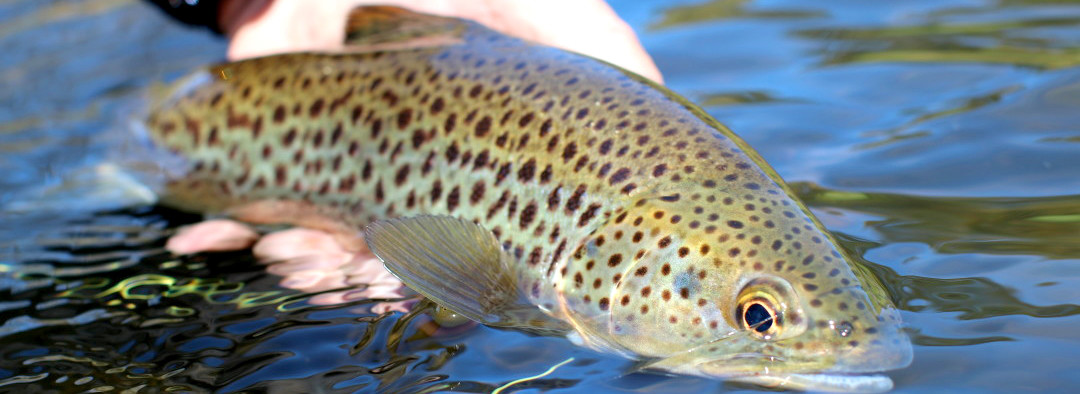There was a short-lived heatwave at the very end of March, with temperatures well into the twenties. I think this peak was a British record for the early spring month, although it did not last very long. More on that below. On the 30th March, Ricky Reno caught a 19.5 pounds salmon on spinner from the Wye’s Clifford beat. This continued the 2021 salmon theme of “lovely fish, but not many of them.” One imagines we started the season on March 3rd with the river very lightly stocked up to about the Welsh border. RJ from Gloucester had a 36 inch salmon on fly from Carrots on the following day. I think we totted up a total of 16 salmon for March, the best of them a 25 pounder from Upper Bigsweir – a lean start to the season.
Meanwhile AB from Usk had 5 trout from the Usk at Chainbridge, while AT of Weobley had a brace from the Lugg at Eyton, along with spotting a goshawk, a roe deer and a grass snake. Eyton on a quiet spring day is a lovely place and I dare say the first warmth of the year would have started the harmless snake moving. DJ from Halesowen was fishing the Arrow at Court of Noke. He didn’t manage any trout, but sent in a photograph of lampreys spawning on the gravel. Of the three British lamprey species, I assume these would have been river lampreys.
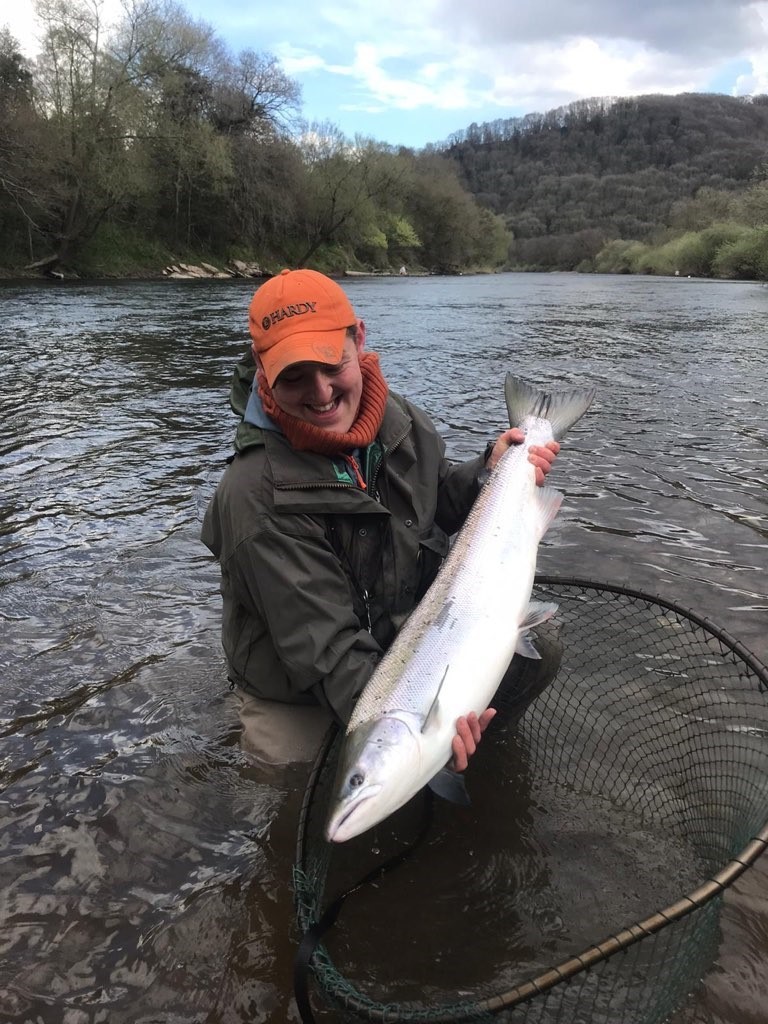 Wyesham 22 pounder
Wyesham 22 pounder  Spawning lampreys on the Arrow - DJ from Halesowen
Spawning lampreys on the Arrow - DJ from Halesowen I have to tell you we were a bit upset by the picture sent in by MH of Swansea on 1st April in which he attempted to demonstrate the correct procedure for photographing and releasing a small porbeagle shark taken on the Usk’s Green Bank. Surely we have given enough advice in the past about photographing and releasing fish for people to get this right? Agreed that “feisty little fella” is the approved kind of comment to be making, preferably in an Australian accent, and MH seems to have taken care to learn the international guide’s technique of balancing the rod across his shoulders while the photograph is taken. All that was just great. But look here, MH, how many times do we have to tell you, the head of the fish has to be held upstream during recovery, not down. Anyway, we hope it went back all right.
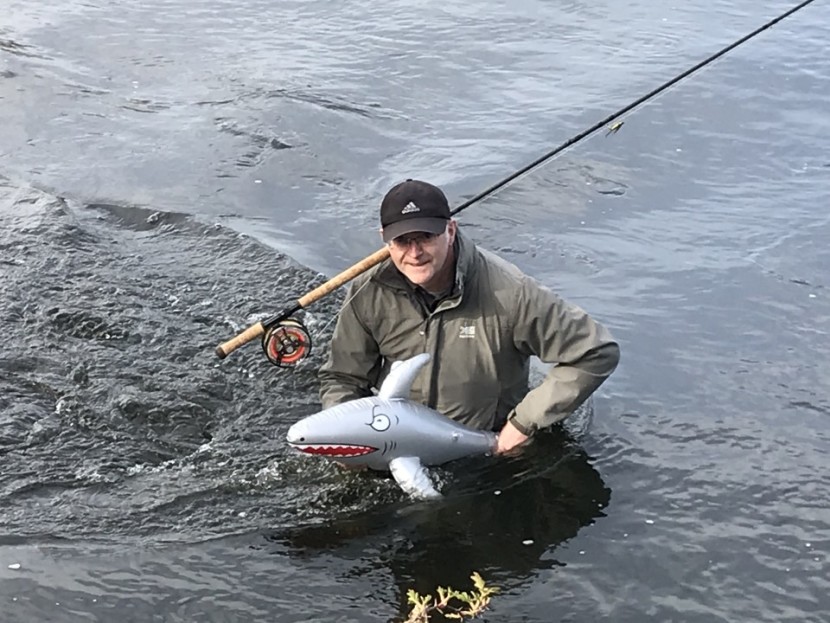 Feisty little fella - MH of Swansea
Feisty little fella - MH of Swansea  Usk grannom feeder
Usk grannom feeder A few more anglers were able to get to work with their rods during the Easter holidays, despite the weather turning cold again. On 2nd April BP from Pembridge took 6 trout on the Golden Valley’s Dore at Chanstone Court. VD from Llanelli with two friends had 22 trout spinning the Aberystwyth AA water of the Rheidol in Central Wales. DO from Aber Village reported a large trout from the Upper Tower water of the Usk. Well done, but as always with specimens, an accurate measurement or weight would have been appreciated. The cold weather did not make for the easiest fishing, but a good number of anglers visited the Beacons reservoirs. AL from Treorchy fished at Llwyn On Reservoir for 8 trout, but complained of finding poachers on the bank when he arrived. We aren’t too much interested in their nationality or ethnicity, but as always with poachers it would be good to know what was done about it at the time? It’s going to be a busy year and I am sure we are going to hear more about poaching.
On the 3rd GC from Pontypridd had a good day on the Usk at Abercynrig. March browns were hatching and he managed 9 trout on March Brown spiders as well as dry flies. On the 4th SE (I think that must be Simon from the Foundation) fished below Llanellen, experienced a grannom hatch as well as March browns, and took 8 trout to 2 pounds. He was using a Klinkhammer-style Grannom Emerger pattern and a sort of dry March Brown made from the fur of his terrier. Shades of the famous “Dogsbody” fly invented by Harry Powell for the Usk a century ago!
On the evening of the 6th I put my head out of the door to find steadily falling snow. The snow was gone by next morning, but the next few days were remarkably cold, more like February than April. About this time there was a proper flush of magnificent springers from the middle of the Wye in the Golden Mile and Carrots area, the best of them a 22 pounder for Jerrie Oddie. On the 8th MG from Cardiff took 4 rainbows from near the dam of the Usk Reservoir using a sinking line and slowly retrieved Booby. AT found nothing rising on the Lugg at Lyepole in the cold, but took 5 trout on a nymph/spider combination. On the 10th NJ from Llandysul fished the Breconshire fishery of the Usk for 9 trout on a “cold and windy morning.” On the same day JM from Cardiff was driven off Llyn Teifi by a snowstorm. JA from Leominster was out on the Arrow at Hergest Court and took 7 trout to 11 inches, but was inconvenienced by bank fencing work – which should be finished early in May. The following day NS from Martley took 6 trout to a pound from Lyepole and wondered whether the famous big grayling of this beat are still present. I think so, but I’m glad they weren’t apparent on this occasion because they should be busy with spawning at this time of the year.
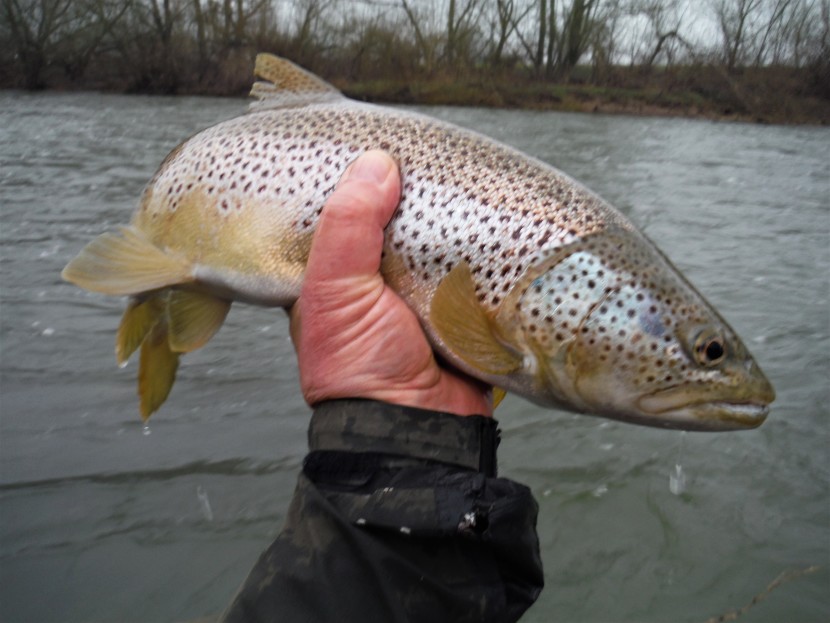 Early season Wye trout
Early season Wye trout  Early spring and Usk fish still a little lean
Early spring and Usk fish still a little lean  Hare's Lug and Plover spider
Hare's Lug and Plover spider 12th April was the long-awaited border crossing date and everything suddenly became very busy as if somebody had fired a starting pistol. Including travelling, I worked 84 hours over the following seven days, mostly with anglers new to the sport. Everybody caught something, mainly on dry flies, and we were able to see some proper hatches of spring olives and grannom, even if they were short-lived around the middle of the day. Personally I seem to have missed out on the March browns this year, just seeing a few specimens. For the most part we used Stuart Jarvis’ Bastard Adams pattern for the olive feeders, and a little Hair Wing Sedge when the grannom were coming off. Waterhen Bloa, Hare’s Lug and Plover and Dark Moorgame proved useful spiders when fishing under the surface.
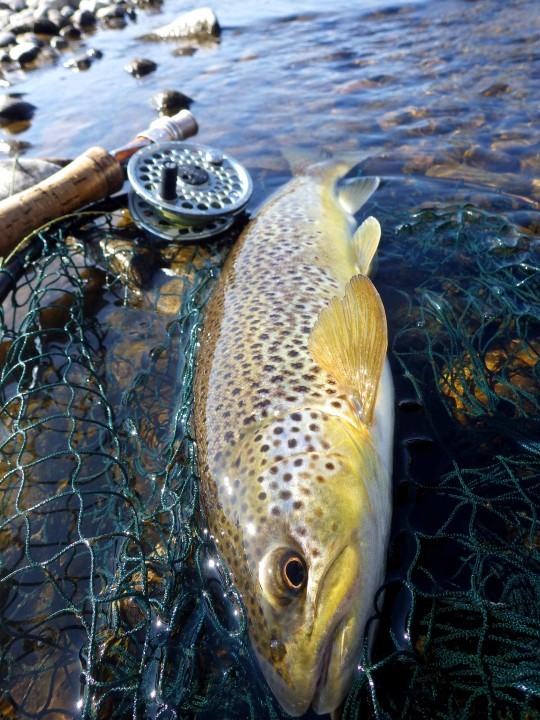 Greenbank trout - SJ from Herefordshire
Greenbank trout - SJ from Herefordshire Conditions were not really ideal, with the rivers very low and clear, and big temperature swings varying from early morning frosts to bright sun and temperatures in double figures after lunch. This April was turning out to be another record month, this time for frosts. For all that, some superb trout were caught in our area. RB from Redditch had 8 trout from the Rectory on the upper Wye. On the 13th VC from Ashford had 17 trout to a very creditable 2.5 pounds during a large dark olive hatch at Abercynrig. That’s what we like to see from the Usk in spring! Next day MW from Bristol reported 4 fish from Penpont, apparently every one of them over 2 pounds! NG from Dilwyn reported 5 from Fenni Fach during a large dark olive hatch, one of them 18 inches – given good condition that would have been 2.5 pounds. SN from Rhayader had a brace including an 18 inch fish from the Irfon at Gofynne. And on the 15th RP from Didcot fishing at Abercynrig reported a brace of “good size WBT (16-20 inches)” using a Pheasant Tail Nymph. I think RP was being unduly modest: a 20 inch wild brown trout in condition is a specimen well over 3 pounds!
Next day at Ashford House PB from Churchdown with a friend reported a brace of specimens at 18 and 20 inches, taken with a Grey Parachute during an olive hatch. Next came a report from SJ of Herefordshire who fished the Middle Usk at Greenbank. Now for those in the know, that is Seth from the Foundation, who with his colleagues does all the hard work (including editing this letter) so that he doesn’t get to go fishing nearly as often as he would like. He told me he was going to try Greenbank, and by all accounts he had a wonderful day, with grannom sedge hatching steadily from 11 in the morning to 3 in the afternoon. He had 7 trout, all but one in the 1.75 to 2 pounds range.
JC from Ross on Wye caught a couple of brown trout from Talybont Reservoir, but was bothered by coracles launched in the lake and music being played on the bank. (Now the coracles got me thinking; I have always wanted to go float-tubing at Talybont, but the rules forbid it). Talybont is normally a very quiet place, but I predict JC’s experience was nothing compared to what will happen when this summer really gets going. About this time we met a pair of paddle boarders on the way down the Usk at Brecon, heading for Abercynrig, Ashford House and the rest of the best trout fishing in Wales. They refused to leave the river. “There’s no law stopping us,” said the young man, not wanting to lose face in front of his girl-friend. Well of course there is, the law of trespass, but he didn’t want to hear about that. Shortly we will be seeing more people in wet suits arriving to play in the rivers we have paid to fish: wild swimmers and a new breed, amateur treasure hunters who have come up with the idea of searching river beds with waterproof metal detectors. And of course there will be the poachers and fly-tippers. I can put up with the dog-swimmers and picnickers on the busier beats and it is only reasonable to expect that in nice weather. But now everybody wants to play out of doors and I predict this year’s silly season will be a long one.
 Trespassing boaters on the Usk in low water - they refused to leave the river
Trespassing boaters on the Usk in low water - they refused to leave the river 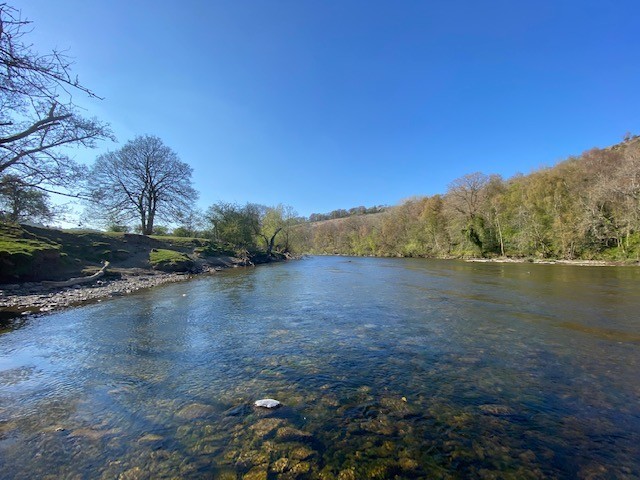 Ty Newydd - PD from Cheltenham
Ty Newydd - PD from Cheltenham VC from Ashford fished again on the 17th at Canal and Rivers Trust water of the Usk and had 5 trout to 1.75 pounds on dries during a mixed hatch. DB from Bristol was fishing Glan y Cafn with a friend on the 18th. They had a couple of trout, but were troubled by “so many people walking on the bank and throwing rocks into the water” which made for hard fishing. AB from Cullompton had a quieter time up at Abercynrig during a March brown hatch: “Beautiful fishing in stunning scenery.” DJ from Halesowen had complaints to make about the access at Ashford House when fishing the following day. I guess this depends how old you are, but I think I agree with him. Ashford House is a great fishery but I really do think the stiles should be fixed after all this time and there is a deep ditch which could usefully be bridged. If it was a club water, it would have been done years ago – the older members would have clamoured for it! (The day after submitting the report I was told the issues at Ashford House had been addressed - see below).
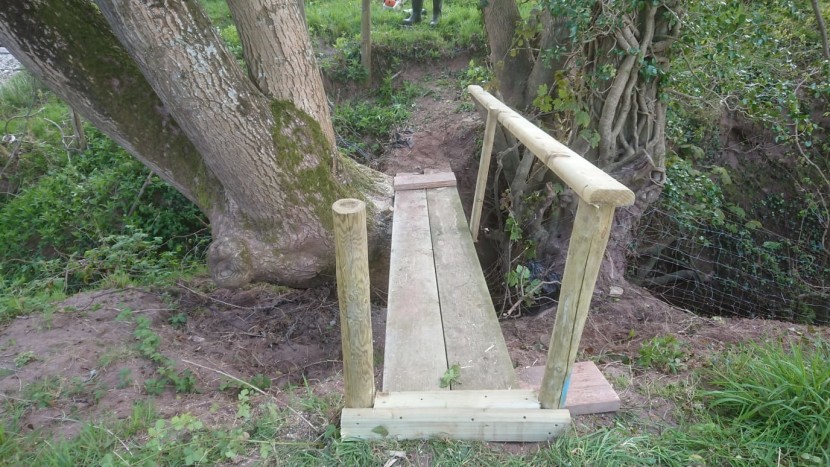
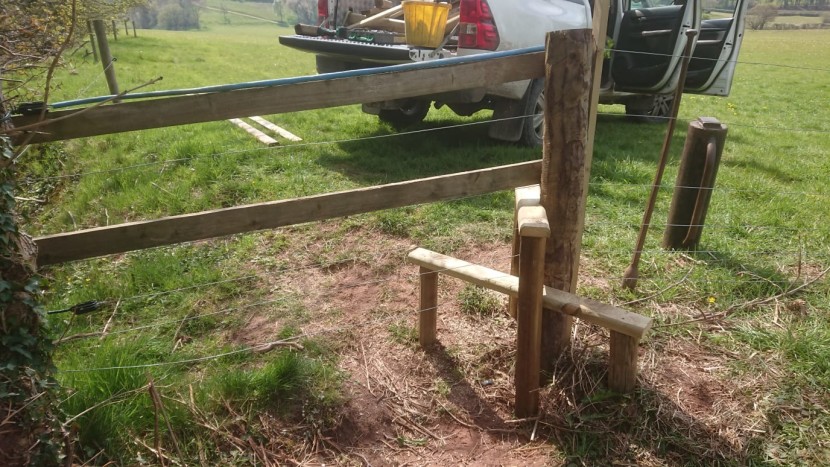
JD from London had 7 trout on nymphs at Lyepole on the 20th, but generally the fishing was becoming quite demanding in the dry bright weather. HJ from Bridgend did well at Abercynrig on the 21st, taking 10 trout mostly on dries during a large dark olive hatch in the fast water. Seth from the Foundation with a friend fished on Ashford House on the following day and they had a dozen trout between one and two pounds between them using nymphs and dries. There was about an hour-long hatch of large brook duns in the middle of the day. (This is the one which looks very like a March brown, but actually isn’t, although a March Brown pattern will usually work just fine). AT from Cobham with a friend had a 2 pounder in a bag of 5 taken at Abercynrig and DW from Hitchin had 8 from the Wye at Ty Newydd on the duo method.
About this time what AH Chaytor in his spring fishing called a “bitter, black east wind” came on to blow for several days. That is mainly an upstream wind on the Usk, but it was cold and strong enough to blow your hat off, and despite the sunlight the hatches were frequently supressed with rises few and far between. On the other hand, when the wind relented slightly there was often a steady trickle of olives and on these occasions some really excellent trout were rising. We were still mainly using dear old Stuart Jarvis’ Bastard Adams pattern in sizes 14 and 16 and it accounted for some good fish. Further downstream the grannom were still coming off when the gale and frosts permitted. I cannot remember such an extended spring grannom hatch. Others were fishing too. On one of the more difficult days I was sitting with a client on the bank at Dinas watching the pool from a distance and we saw a very large cormorant dive deep and come up with a 2 pound trout. It swallowed the whole thing eventually, although for 5 minutes you could see the outline of the live fish kicking in the bird’s gullet. Not a pretty sight. Our fish have a hard time of it between the goosanders and the cormorants, especially when the levels are low. Despite the devilish appearance of the cormorant with his hooked hack-saw bill, I don’t exactly blame the bird. Eating fish is what he was born to do. I blame ourselves for failing to control a predator to protect another species we love and appreciate in so many ways, including as an economic resource. Please don’t tell me about limited licences to shoot a restricted number of birds or contributions to yet another anglers’ survey to find out if they eat fish or not; these measures have proved to be quite inadequate. If pigeons can be on the general licence, so should cormorants be while inland.
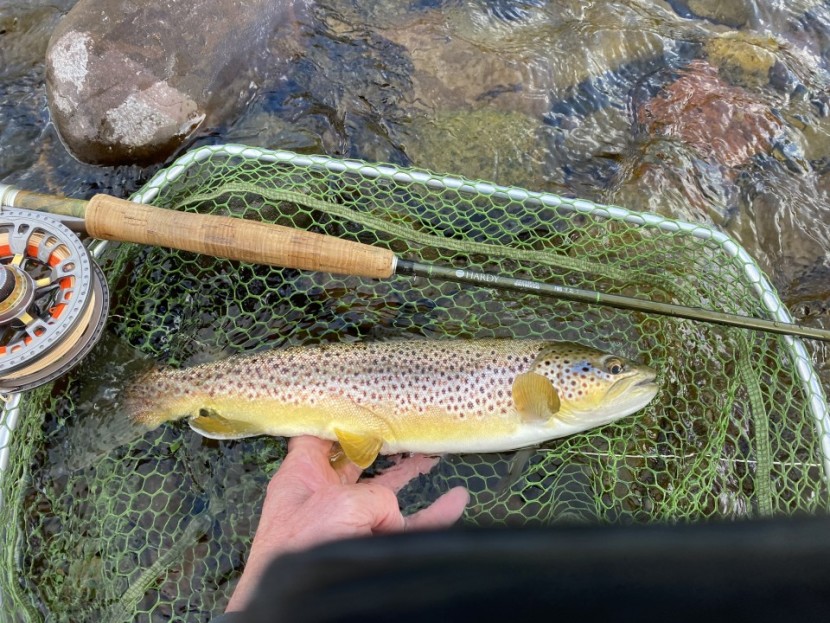 Breconshire trout - NJ from Llandysul
Breconshire trout - NJ from Llandysul  Bastard Adams
Bastard Adams  First Usk trout of the season on a Bastard Adams during an olive hatch
First Usk trout of the season on a Bastard Adams during an olive hatch 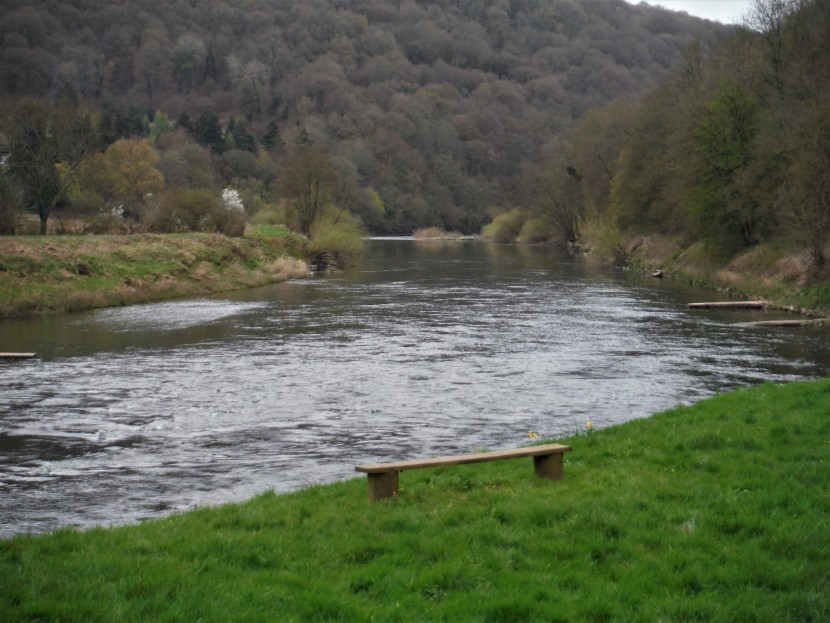 Lower Wye at Bigsweir
Lower Wye at Bigsweir Another busy weekend followed. KM from Maidstone had 10 trout from Abercynrig on the 23rd. PD from Cheltenham followed that up with 13 from Ty Newydd on dry flies. On the 25th TD from Amport, one of our regulars I think, fished the Usk at Ashford House and caught half a dozen from 10 inches to a brace at 16 inches on a March Brown Jingler, this during a hatch of March browns – or possibly large brook duns? The difference comes down to the venation of the wings and the markings on the leg joints. More practically if glimpsed at a distance, LBDs are distinctly yellowish in tinge. On the 26th PD from Cheltenham reported a 2 pounder taken on the dry fly at Penpont.
Salmon fishing had by now slowed right down, the rivers having dropped back to summer level, very low and clear. As there was almost no weed, this was a good time to walk along the river and at least gain a knowledge of the pools. The main chance seemed to be below Monmouth, with the odd fish fresh off the tide. Interestingly, a shoal of twaite shad were seen moving upstream in the Upper Bigsweir beat, which seems very early. Stranger still, somebody caught an 8/9 pounds rainbow in the lower river. Very high spring tides near the end of the month produced a few more for Wyesham. More than that, a report from EO of Salisbury on the 28th caught my eye. He described the river as “in fine fettle,” which seemed distinctly odd. But he lost what he described as a strong fish in the Maddox and saw salmon move, not only in the Vanstone which seems to hold salmon in almost every month of the year, but also in Dog Hole and the V, which got me thinking that some at least must be moving up above Monmouth even in this low water. I was tempted to go then and fish the Ross water directly upstream, but I was engaged elsewhere.
So we came to the end of the coldest April for a long while. I saw a frost on every morning but one and, writing this on 1st May, there is again a morning frost although the sun will chase it away. Late as the spring was for the most part and restricted as our movements were, I had a few memorable “match the hatch” experiences during last month. One was at our Forest pool on a day with a bitterly cold wind blowing intermittently up and down the lake. But every time the wind dropped and the surface became smooth, a series of explosive rises could be seen from fast moving shoals of quite newly stocked rainbows.
Now people tend to imagine that stocked fish are fixated only on trout pellets. That is not quite true. Even in a stew pond, fish get a few opportunities to learn what live food is. Just watch when a mayfly strays onto the surface of one of the rearing tanks and see how long it survives. On this day the cause of the excitement seemed to be a type of greyish black midge species, which was coming off in small numbers. I’m pretty certain this was the duck fly, Chironomus tentans, which can sometimes result in massive spring hatches, for example at Talybont Reservoir. However, on such a chilly day this hatch was a modest affair. Spring buzzer fishing is famous, but usually when fishing for chironomid feeding trout we are imitating some earlier phase of the insect’s life: Bloodworm for the larva, Superglue Buzzer for the pupa, or maybe Diawl Bach or Cruncher as the insects begin to emerge. This time not much was going on below the surface, but the fish definitely wanted the adults. A few years ago I acquired a recipe for a family of Dry Buzzer patterns which are all very easy to make and with enough colour variations to imitate any sort of adult midge. Like most imitations of different phases of the midge’s life, it looks quite simple and scruffy; however, I pass it on to you because it does work. I used the black one on this occasion and although it was not always easy to place it accurately in front of fast-moving fish just below the surface, I accounted for four rainbows before the hatch stopped and the fish went down. When taken, it was taken with great confidence. I must have copied this pattern from one of the magazines, but I am afraid that I forgot to note the originator, for which I apologise. I have found the olive, black and grey versions of it to be the most useful on the still waters I fish. Here it is:
Dry Buzzer (Black):
Hook: Kamasan B170 12 or 14, more often 14
Thread: Black 8/0
Rib: Fine silver wire
Body: Black seal’s fur
Head hackle: Short badger cock.
The same badger cock hackle is used for all the versions, but the remaining body and rib colour variations are as follows:
Grey: Natural grey seal’s fur / fine copper wire
Olive: Dark olive seal’s fur / fine gold wire
Claret: Claret seal’s fur / gold wire
Brown: Fiery brown seal’s fur / gold wire
Ginger: Ginger seal’s fur / gold wire
Orange: Orange seal’s fur / gold wire
 Various buzzers
Various buzzers  Olive Dry Buzzer
Olive Dry Buzzer After several disappointing years, 2021 was also a very good spring for the grannom sedge and the hatches went on for a long time. Even while salmon fishing in March I saw some good hatches on the lower Wye, with the adults mating and crawling all over bankside willow trunks before the famous upstream migration of females later in the day. I normally associate grannom with spring sunshine and the hatch is often dramatic but over quickly. On the Usk I sometimes try a team of Hare’s Lug and Plover spiders below the surface when the fish seem to be going crazy for the ascending pupae. The golden plover wing covert feather is exactly the right shade of mottled yellow to match the insects. However, more memorable this year was a slow-burning grannom hatch I found in progress when invited to Monnow Valley after a single unusually warm night. (This was the one untypical day of this spring, the warmest 24 hours during many weeks). I have become somewhat worried about the main Monnow lately; although it still yields some beautiful specimen trout on occasions, usually to the dry fly, I’m convinced that there should be more of the routine 10 and 11 inch fish to be expected in a healthy river. Where have the numbers of pretty yellow trout gone? As a result, you find yourself searching a few known hot spots, possibly for fish you have caught before. There was a particular fish in a particular place which I definitely caught three times last season. Much of the river seems comparatively barren compared to the numbers it bred 10 years ago.
 Mating grannom
Mating grannom 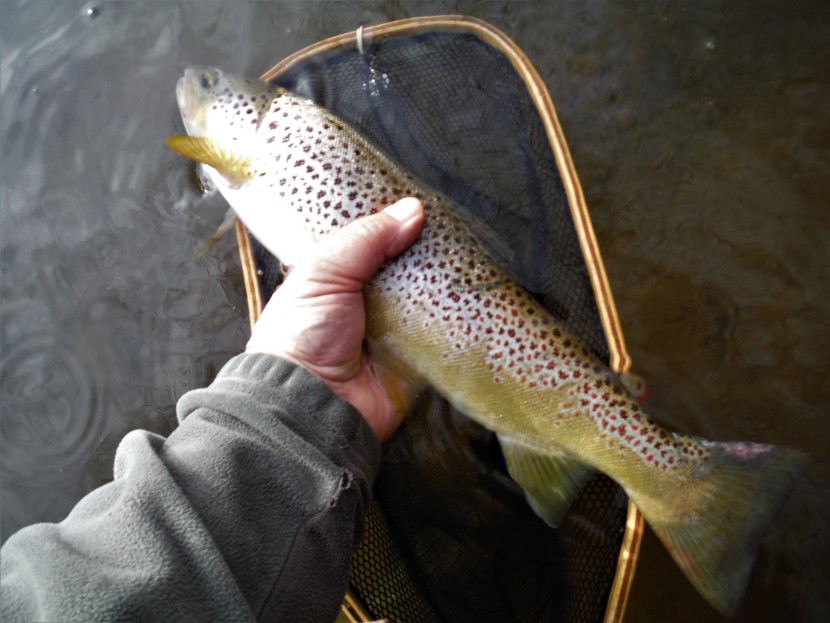 17 inch grannom feeder
17 inch grannom feeder Still, on a sunny morning at Monnow Valley it was a lovely sight looking down from the bank through the branches at a big lazy trout slowly winding up to the surface to take in an adult grannom every few seconds. The flies seemed to have trouble getting off the surface, so he was in no hurry. I like to encourage myself by reflecting that if you can see this much of a feeding fish on the Monnow, you have a more than 50% chance of securing him. (Whether true or not, the idea gives confidence). I had with me a 9 foot dry fly rod made up with a size 16 Baetis Duck’s Dun on the leader because I had been expecting olives. A couple of minutes to get into position below the fish and off to the side by a few yards and I tried him without changing the fly. He had it the second time over, a 17 inch trout which jumped a couple of times before coming to the net. I swear to God this was a fish which I had tried for over a couple of seasons, having missed the take several times and been broken off once by the willow roots. Who knows? It was at any rate in the same place.
Above the mill-house and recording studio, one of the old reliable hot-spots was now obscured by a tree which had fallen in during the winter. There seemed to be nothing moving around this area. But round the corner, again from above, I saw another large dark fish rising to grannom in the channel. Most of the hard work involved getting down the steep bank through freshly sprouting brambles and positioned in the river downstream ready for a cast up and across. I kept the Duck’s Dun on, tail and all, as it had worked before, and it was accepted at once by a cock fish of 16 inches. In fact I had an idea that this was not the fish I had seen originally, which had looked somewhat larger. Now the area was thoroughly disturbed. Never mind, I had a lovely brace already and flies were still hatching.
I went up to the top of the beat, which is quite a tramp through the fields, to be gratified by the sight of several smaller trout rising at grannom on a pool tail. These rises were an altogether more explosive affair, the kind we are more used to seeing, and perhaps as a result I missed several. I did get two more, however, fat trout of 10 and 13 inches which seemed to have got through the winter in good condition. Finally, at the very top of the beat I reached another known hotspot where I saw nothing rising. Still, I wasn’t going to miss prospecting my fly down the run after that long walk, and sure enough another really good trout came up and engulfed it. Nervous for some reason, I struck too soon and missed it. And that was it for the day; all activity stopped at one o’clock with the air temperature at a surprising 23 degrees. A lovely morning for early spring, I thought.
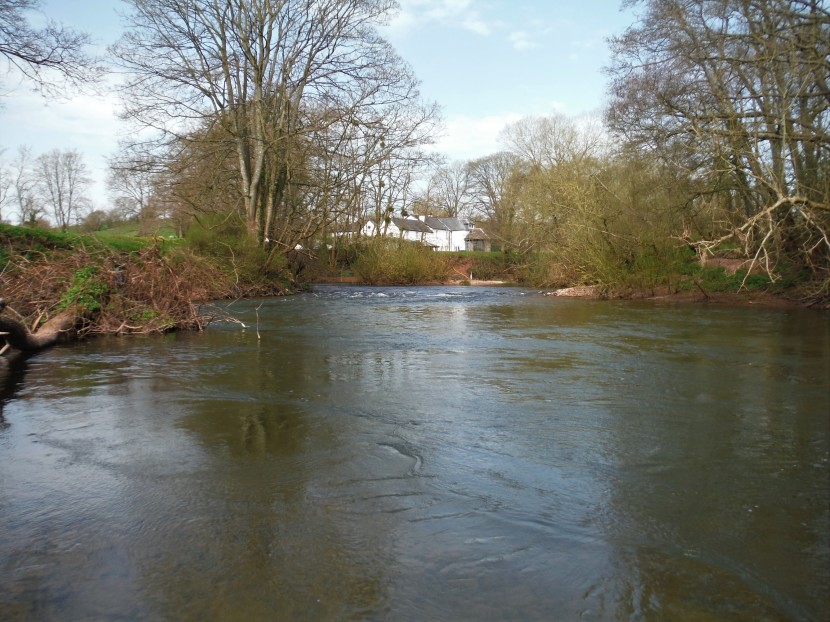 Mild spring weather on the Monnow
Mild spring weather on the Monnow 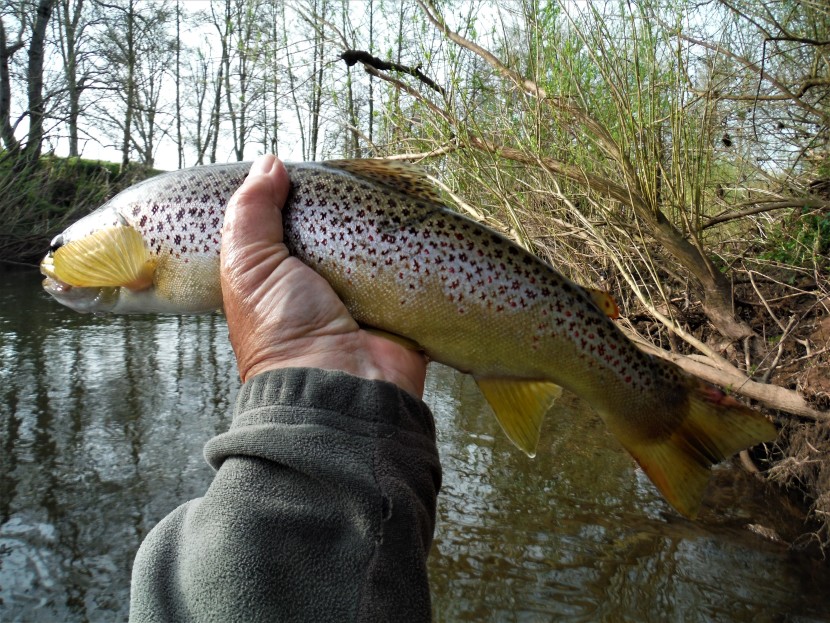 Monnow Valley trout
Monnow Valley trout I did a lot of fly-tying during lock-down this winter. Well, didn’t we all; what else was there to do? While I was busy at the bench the other evening, I realised that I was getting to the end of the current jungle cock cape. Jungle cock eyes are an important resource for those who dress salmon and sea trout flies. It wasn’t that the old cape was completely finished; it was just that most of the useful sizes were used up. This happens with nearly all capes sooner or later. There were still plenty of the largest exclamation mark orange/black/white eyes left, enamelled giants big enough to make cheeks for 4 inch tubes, along with tiny ones you could add to a size 12 Diawl Bach if you wanted to. I would probably use up the small ones eventually. The remaining big ones could even be used to make some of those vintage patterns using four giant jungle cock eyes as wings. I am not sure I would ever getting round to fishing them. But those useful middle sized ones, the ones I need all the time to make cheeks for a size 8 double Bann Shrimp or a 1.25 inch Black and Yellow tube are just about done. Time for a new cape.
 Jungle cock half-used
Jungle cock half-used Time for a shock in fact! Jungle cock capes were always relatively expensive and I remember paying 50 pounds for the last one. However jungle cock eyes create a tremendous “sighting spot” effect on any fly to which they are added and I never saw an artificial substitute which compares with the real thing. Long ago I convinced myself I need them. Now it seems there is a scarcity of capes and I will have to pay at least twice that to get a decent one now, more again for a really good one.
The shortage is slightly surprising. The wild birds belong to South Asia and are important because they provided the main gene pool originating the world’s domestic chickens. In fact I think there are three sub-species, the red and grey jungle fowls of India and the Sri Lanka jungle fowl. The last version used to be common enough. Many years ago I was lucky enough to spend a week in the Wilpattu game reserve in the northern dry zone of Sri Lanka and jungle fowl seemed to be scuttling around our wheels wherever we went. I was impressed with these handsome birds, but not so the tracker, who instead became excited about a mallard he saw on one of the tanks. “Very rare,” he kept on saying. I didn’t want to rain on his parade by pointing out that mallard duck were two a penny where I came from. We had a good time, even though the old Series 2 Landrover blew a core plug out of the block and we had to spend an evening out in the bush carving a replacement from the end of an axe handle and hammering it into position. We saw a good number of leopard on that trip, and I imagine a nice fat jungle fowl would be a good substitute meal for any leopard who felt too lazy that day to tackle a spotted deer.
However, the Sri Lankan jungle fowl is not the one we need for fly dressing, handsome as it is. The cock of the grey jungle fowl of India is the one sporting those amazing fused neck feathers. Although the species is not officially threatened yet either in numbers or in habitat, trade in them is protected by a CITES prohibition. The feathers of wild birds cannot be imported legally. Instead, the fly dressing market has been supplied to date by a succession of domesticated birds reared in the UK and USA since the seventies. Although they are supposed to be easy to breed, there never seem to be quite enough of them to go round.
“Tied enough flies? Try building your own rod!” This from a Bloke Fly Rods advertisement in Fly Fishing and Fly Tying. What a good idea and what a clever advertisement! I’m quite tempted to start rod building again. Bloke can sell you everything from blanks and individual items to full kits.
There was a time when DIY rod building was quite the rage, mainly as a way of saving money. Back in the split cane era I built quite a few. I should make it clear that in my case there was never any question of actually shaving down and splitting cane before gluing strips together to make the hexagonal blank. That is very skilled work indeed, and something I could never aspire to. But in those days it was also possible to buy the manufactured blanks along with a kit to finish the rod. This involved fitting brass male and female ferrules to the blanks, gluing on and sanding the corks to make the handle to the lower blank, fitting the reel attachments, end cap etc, whipping on rod rings and finally applying lacquer and varnish.
If I remember rightly, I used to buy these kits from a firm called JB Walker – which is not to be confused with B James Rods which later became the modern Bruce and Walker company. There was another Walker involved, however, because the first two rods I built from these kits were the MK4 and the stepped up MK4, both on two piece blanks designed by the famous angler and writer Dick Walker. The first one was intended for carp and the second, heavier version, was capable of casting a dead bait for pike. I still have the stepped up variant, which I found to be a bit of a brute of a rod without much feel to it. But the MK4 carp rod was a tool to love: light, flexible and perfectly designed in every way for its intended purpose. It cast a variety of different weights with ease and delicacy and it was the design which in 1954 Richard Walker had used to capture Clarissa, at the time the record British carp of 44 pounds. I eventually caught a leather carp of just under 30 pounds with my one. I remember the corks of the handle curving in my hands and hearing a very slight creaking at moments of stress. I can understand those who claim a wooden rod gives you “feel” like no other material.
However, first came an early disaster. I was playing a wild carp of about 4 pounds in one of my local ponds when the rod suddenly collapsed at the female brass ferrule. If the ferrule had actually broken, the top joint would have slid down the line until it bumped the fish on the nose. As it was, the carp seemed to be as shocked by the accident as I was; using just the handle and stiff lower joint like a truncheon I was able to bring it to the net without much more fuss. I quickly realised the fault was mine. When fitting the female ferrule to the lower section, it is necessary first to reduce the size of the wooden blank slightly and round off the 6 corners by sanding. There is an inherent danger to this, as the strength of cane lies in its outer skin. Then the ferrule is heated up to expand it slightly, glue is applied, and finally the hot ferrule is drifted carefully onto the blank with a rubber mallet and a wooden block. My mistake had been to fail to reduce the diameter of the blank enough and thus also to fail to drift the ferrule far enough into position. As a result, when the rod was assembled there was too large a gap between the two wooden sections, bridged only by a thin-walled brass tube – which duly buckled and collapsed under pressure. All ended well; JB Walker sent me another ferrule and this time I fitted it properly. Sad to tell, the rod was stolen from me a few years later. If you ever come across a cane rod with my name signed and the date 1973 under the varnish, it’s mine!
The work of rod construction was changing, because about this time fibre glass was arriving. I turned my hand to building a fly rod from fibre glass tube. In practice rod assembly had become easier than ever, because there were no longer brass ferrules to worry about. Instead the two sections made from rolled fibre glass sheet fixed with resin had already been fitted with a spigot joint. Later we had tapered over-fit joints already provided on the blanks. Note that in those days, two piece rods were almost ubiquitous for anything up to 10 feet. You can easily tell a survivor from the fibre glass era, because the diameter of the tubes are almost twice what we have now come to expect in the carbon era. My first effort was a powerful 10 footer intended to deal with heavy sinking lines and lures, even tube flies fished from a boat. The blanks I bought were listed as suitable for grilse or sea trout and I think for a 9 weight line. Fishing with this creation was certainly hard work; I still have it although it has not been used for years. Next came a 9 foot rod with a fairly soft action to take a 6 weight line. I had a lot of fun with that one, and actually used it so much that the rings wore out. At that point I had the bright idea of re-ringing it with a full set of wear-proof Fuji rings with ceramic inserts. Unfortunately, the extra weight of the set just about destroyed the action.
Looking today at these home-made rods of mine, they seem pretty battered. I was not so very neat in constructing them in the first place and I think we gave our rods a hard time altogether in those days. For a start the kits arrived with rod bags, not tubes, and mine were rattled together with others in and out of boats and thrust unceremoniously for transport into the passenger foot well of the old Triumph TR2 I used to drive. Believe me, there isn’t much room for tackle or anything else in a TR2. Initially, the change to fibre glass rods seemed like a blessing, if only because they were so much lighter than cane. However, they lacked feel and certainly lacked accuracy. (To get an idea of how floppy they were, just look at the photograph of Oliver Kite in his famous book on nymphing, casting enthusiastically with a Milbro glass rod).
It wasn’t until carbon arrived a little later in the seventies that I began to appreciate what a really fine fly rod could and should be: simultaneously light and sensitive, tracking and recovering accurately. In fact my own first rod from the space age material was another carp rod and I loved it. Since then I have been buying fully made-up carbon fly rods from well-known suppliers, because for a long time there was no real price advantage to buying blanks and rod parts separately. I suspect the situation may have changed now, though, with some top range trout rods being offered at nearly 1,000 pounds. For that reason alone, there might be a real value to making up your own. On reflection, if you feel you would like to have a go at building a rod for the first time, you will probably be able quite easily to create something more than good enough to fish with. Most home workshops will have the sanding paper, paint brushes and other simple tools needed. If you are keen to achieve a really professional finish, though, you might want to invest in some extra equipment such as a slow-turning electric lathe with mandrel to spread drying lacquer evenly on rod whippings.
As everybody knows, there was some sobering news this month. I was busy worrying about the Northern Ireland protocol and whether there was any sign of the much discussed goodwill and sense of fair play needed to make it work – no sign yet for sure and maybe my original optimism was misplaced. We were all of course very much engaged with the pandemic, lockdown measures, vaccines et al. And then came the hardly unexpected, but nevertheless sad, news of the loss of the Duke of Edinburgh. Other concerns were forgotten for a while. The eulogies came pouring in at once and I can hardly add to them. The Prime Minister of Australia spoke of the man’s candour, his intelligence and absolute reliability, his support to the Queen and a lifetime of hard-working service to his country. Many who knew the Duke of Edinburgh emphasised how much he read and how searching were his questions. Somewhat politically incorrect, some would say gloriously so, he was in fact a very forward-looking man, concerned for the effective role of the royal family in the service of the nation and the Commonwealth.
It was not an easy life by any means and I found myself reflecting on what a very unusual life it was. For example the Greek connection is not always understood today. Although he was baptised into the Orthodox Church, Philip himself had no Greek blood but came from the House of Glucksburg. These Danish-German aristocrats were related in some way or another to nearly all the crowned heads of Europe, including Queen Victoria of course, and had been selected by the Great Powers from a relatively short list as monarchs for the newly independent and distinctly unruly nation of Greece. During the 19th century, the diplomats and ministers of the great European nations automatically saw the installation of a suitable monarch as the natural solution to stabilise a new nation. The American presidential model was still regarded as distinctly dubious. When Greece won its independence from the Ottoman Empire in 1828, they started with the Wittelsbach Otto of Bavaria who was sent with a hastily assembled court to Athens, and when that didn’t work out so well, the international statesmen eventually turned to the Glucksburgs. So, for much of its short history, the politics of modern Greece were divided between loyal monarchists and fiercely opposed republicans who saw a “foreign king” as no more than a device for more powerful nations to interfere in Greek affairs. There was probably some truth in that accusation. It was an uncertain job, being King of the Hellenes, and at the beginning of the 20th century King Alexander was said to have kept a suitcase packed ready at all times in the Tatoi Palace. Times were turbulent throughout the Balkan Wars by which Greece doubled its territory, the Great War and above all the disastrous war expedition against Turkey in Asia Minor, after which the military commander and five cabinet ministers deemed responsible were hanged. Greek Kings came and went, although not with quite the rapidity of Greek Prime Ministers. So it was that at 18 months old, reportedly in an orange box, Philip was handed up to a British destroyer as members of the Glucksburg family were evacuated from Corfu. This would have happened in December 1922 in the aftermath of the Asia Minor War as King Constantine was forced to abdicate and members of his family were considered to be at risk. Philip’s father, who had fought in Asia Minor, was Prince Andrew of Greece and Denmark; his mother was Princess Alice of Battenburg, a great grand-daughter of Queen Victoria.
As we know Philip came to be educated in Britain at Gordonstoun School with an emphasis on sports and outdoor life. He was a popular young man and many doors were open to him. In 1941 as a young naval officer he commanded a searchlight battery on HMS Valiant at the Battle of Matapan. On a dark night off the southernmost cape of mainland Greece, this must have been a terrifying engagement between full battleships and heavy cruisers with 15 inch shells being lobbed in all directions. Italian heavy cruisers and destroyers were sunk and more than 3,000 Italian sailors died or were captured. A few years later, through binoculars, Philip was able to watch General MacArthur accept the Japanese surrender on the deck of the USS Missouri while anchored in Tokyo Bay. There must be relatively few people left alive today who have witnessed such events as these. Quite apart from the well-deserved plaudits for public service, it’s a cause for wonder and celebration when contemplating a very long life such as that of the Duke of Edinburgh, what he must have seen and whom he must have known. And I can only imagine the memories HM the Queen must have of the fascinating people she has met during her long reign, beginning with Churchill as Prime Minister. However, one doesn’t gossip, I suppose…
Tight lines for May!
Oliver Burch
